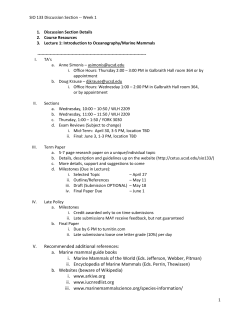
Marine Environment: Selective Forces for Secondary Marine Forms
SIO133 Week 2 Study Guide Relevant Lectures: Marine Environment: Selective Forces for Secondary Marine Forms Cetacean Taxonomy Marine Environment: Selective Forces for Secondary Marine Forms Property of Water Effect on Marine Mammals Density High thermal conductivity Less oxygen than air Light does not propagate well Sound does propagate well Different habitat than land/air 1. Define “Secondary Marine Forms” 2. What physical property of water has had the greatest effect on the evolution of marine mammal locomotion? Describe at least 4 associated adaptations in marine mammals. 1. 2. 3. 4. 3. Why does it make sense that whales have kept their lungs after adapting to the marine environment? 4. What physiological mechanisms prevent deep diving marine mammals from getting “the bends”? 5. Describe “telescoping” as it relates to marine mammal morphology. 6. What is Fick’s Law and what does it describe? Relate evolved characteristics of marine mammals to the different components of Fick’s Law. Q= Component Q k A l ∆t Description kxA ∆t l Marine mammal adaptation 7. How have the properties of water influenced the skeletal function and morphology of marine mammals? General Skeleton: Spine: Appendages: Feeding mechanisms: Cetacean Taxonomy 1. Define the following Taxonomy: Classification: Systematics: 2. What is the primary source of evidence used in marine mammal taxonomy? 3. What other lines of evidence have more recently been considered? 4. Compare the diversity of marine and terrestrial mammals. What environmental factors might account differences in diversity? 5. What are the two major suborders within the Order Cetacea? a. Which of these is more diverse? b. What are 5 major differences between these suborders? 1. 2. 3. 4. 5. 6. Describe some differences between dolphins and porpoises 7. Which cetacean family has the most diversity in terms of number of species? 8. Name each cetacean family, describe some identifying characteristics and give an example of one of its species Family Characteristics Example Species (common and scientific name)
© Copyright 2025














